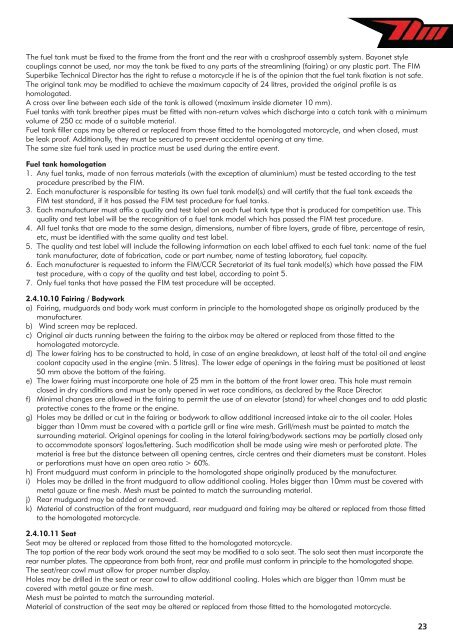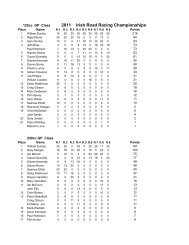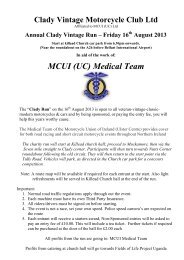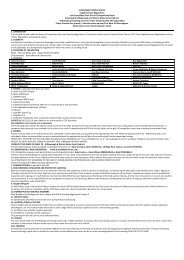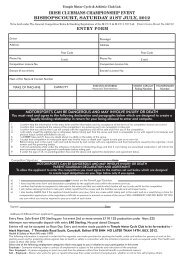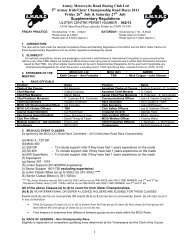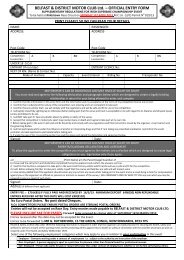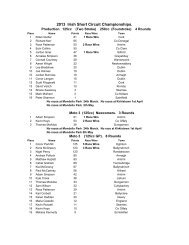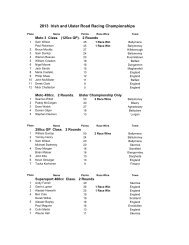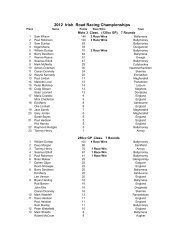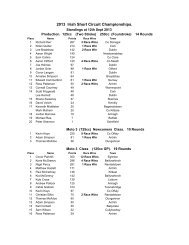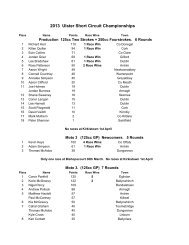2012 InternatIonal north West 200 Motor CyCle road raCe - MCUI(UC)
2012 InternatIonal north West 200 Motor CyCle road raCe - MCUI(UC)
2012 InternatIonal north West 200 Motor CyCle road raCe - MCUI(UC)
Create successful ePaper yourself
Turn your PDF publications into a flip-book with our unique Google optimized e-Paper software.
The fuel tank must be fixed to the frame from the front and the rear with a crashproof assembly system. Bayonet style<br />
couplings cannot be used, nor may the tank be fixed to any parts of the streamlining (fairing) or any plastic part. The FIM<br />
Superbike Technical Director has the right to refuse a motorcycle if he is of the opinion that the fuel tank fixation is not safe.<br />
The original tank may be modified to achieve the maximum capacity of 24 litres, provided the original profile is as<br />
homologated.<br />
A cross over line between each side of the tank is allowed (maximum inside diameter 10 mm).<br />
Fuel tanks with tank breather pipes must be fitted with non-return valves which discharge into a catch tank with a minimum<br />
volume of 250 cc made of a suitable material.<br />
Fuel tank filler caps may be altered or replaced from those fitted to the homologated motorcycle, and when closed, must<br />
be leak proof. Additionally, they must be secured to prevent accidental opening at any time.<br />
The same size fuel tank used in practice must be used during the entire event.<br />
Fuel tank homologation<br />
1. Any fuel tanks, made of non ferrous materials (with the exception of aluminium) must be tested according to the test<br />
procedure prescribed by the FIM.<br />
2. Each manufacturer is responsible for testing its own fuel tank model(s) and will certify that the fuel tank exceeds the<br />
FIM test standard, if it has passed the FIM test procedure for fuel tanks.<br />
3. Each manufacturer must affix a quality and test label on each fuel tank type that is produced for competition use. This<br />
quality and test label will be the recognition of a fuel tank model which has passed the FIM test procedure.<br />
4. All fuel tanks that are made to the same design, dimensions, number of fibre layers, grade of fibre, percentage of resin,<br />
etc, must be identified with the same quality and test label.<br />
5. The quality and test label will include the following information on each label affixed to each fuel tank: name of the fuel<br />
tank manufacturer, date of fabrication, code or part number, name of testing laboratory, fuel capacity.<br />
6. Each manufacturer is requested to inform the FIM/CCR Secretariat of its fuel tank model(s) which have passed the FIM<br />
test procedure, with a copy of the quality and test label, according to point 5.<br />
7. Only fuel tanks that have passed the FIM test procedure will be accepted.<br />
2.4.10.10 Fairing / Bodywork<br />
a) Fairing, mudguards and body work must conform in principle to the homologated shape as originally produced by the<br />
manufacturer.<br />
b) Wind screen may be replaced.<br />
c) Original air ducts running between the fairing to the airbox may be altered or replaced from those fitted to the<br />
homologated motorcycle.<br />
d) The lower fairing has to be constructed to hold, in case of an engine breakdown, at least half of the total oil and engine<br />
coolant capacity used in the engine (min. 5 litres). The lower edge of openings in the fairing must be positioned at least<br />
50 mm above the bottom of the fairing.<br />
e) The lower fairing must incorporate one hole of 25 mm in the bottom of the front lower area. This hole must remain<br />
closed in dry conditions and must be only opened in wet race conditions, as declared by the Race Director.<br />
f) Minimal changes are allowed in the fairing to permit the use of an elevator (stand) for wheel changes and to add plastic<br />
protective cones to the frame or the engine.<br />
g) Holes may be drilled or cut in the fairing or bodywork to allow additional increased intake air to the oil cooler. Holes<br />
bigger than 10mm must be covered with a particle grill or fine wire mesh. Grill/mesh must be painted to match the<br />
surrounding material. Original openings for cooling in the lateral fairing/bodywork sections may be partially closed only<br />
to accommodate sponsors' logos/lettering. Such modification shall be made using wire mesh or perforated plate. The<br />
material is free but the distance between all opening centres, circle centres and their diameters must be constant. Holes<br />
or perforations must have an open area ratio > 60%.<br />
h) Front mudguard must conform in principle to the homologated shape originally produced by the manufacturer.<br />
i) Holes may be drilled in the front mudguard to allow additional cooling. Holes bigger than 10mm must be covered with<br />
metal gauze or fine mesh. Mesh must be painted to match the surrounding material.<br />
j) Rear mudguard may be added or removed.<br />
k) Material of construction of the front mudguard, rear mudguard and fairing may be altered or replaced from those fitted<br />
to the homologated motorcycle.<br />
2.4.10.11 Seat<br />
Seat may be altered or replaced from those fitted to the homologated motorcycle.<br />
The top portion of the rear body work around the seat may be modified to a solo seat. The solo seat then must incorporate the<br />
rear number plates. The appearance from both front, rear and profile must conform in principle to the homologated shape.<br />
The seat/rear cowl must allow for proper number display.<br />
Holes may be drilled in the seat or rear cowl to allow additional cooling. Holes which are bigger than 10mm must be<br />
covered with metal gauze or fine mesh.<br />
Mesh must be painted to match the surrounding material.<br />
Material of construction of the seat may be altered or replaced from those fitted to the homologated motorcycle.<br />
23


